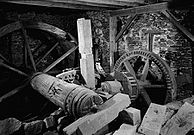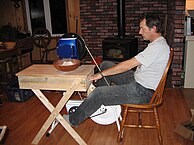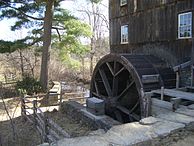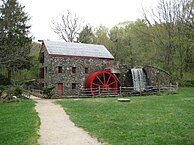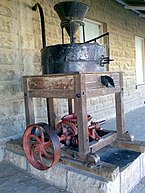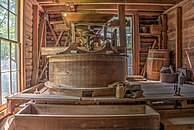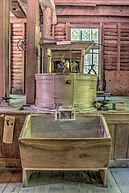Gristmill

A gristmill (also: grist mill, corn mill, flour mill, feed mill or feedmill) grinds cereal grain into flour and middlings. The term can refer to either the grinding mechanism or the building that holds it. Grist is grain that has been separated from its chaff in preparation for grinding.
History
Early history

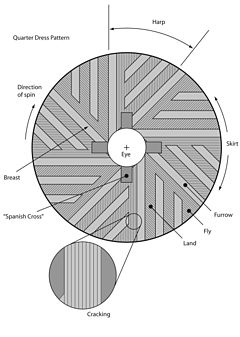
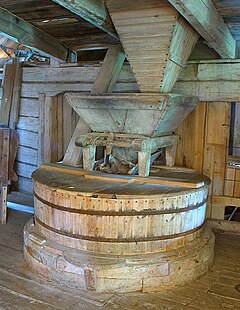

The Greek geographer
The early mills had horizontal paddle wheels, an arrangement which later became known as the "
Manually operated mills utilizing a crank-and-connecting rod were used in the
There was an expansion of grist-milling in the
From the late 10th century onwards, there was an expansion of grist-milling in Northern Europe.[9] In England, the Domesday survey of 1086 gives a precise count of England's water-powered flour mills: there were 5,624, or about one for every 300 inhabitants, and this was probably typical throughout western and southern Europe. From this time onward, water wheels began to be used for purposes other than grist milling. In England, the number of mills in operation followed population growth, and peaked at around 17,000 by 1300.[13]
Limited extant examples of gristmills can be found in Europe from the
Classical British and American mills
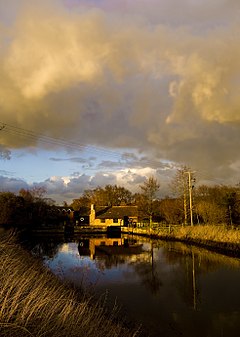
Although the terms "gristmill" or "corn mill" can refer to any mill that grinds grain, the terms were used historically for a local mill where farmers brought their own grain and received ground meal or flour, minus a percentage called the "miller's toll."[14] Early mills were almost always built and supported by farming communities and the miller received the "miller's toll" in lieu of wages. Most towns and villages had their own mill so that local farmers could easily transport their grain there to be milled. These communities were dependent on their local mill as bread was a staple part of the diet.
Classical mill designs are usually
In most wheel-driven mills, a large gear-wheel called the
The millstones themselves turn at around 120
The grain is lifted in sacks onto the sack floor at the top of the mill on the
In order to prevent vibrations from the millstones shaking the building apart, they were usually placed on a separate timber foundation, not attached to the mill walls, known as a husk. This foundation isolated the building from vibrations coming from the stones and main gearing and also allowed for the easy re-leveling of the foundation to keep the millstones perfectly horizontal. The lower bedstone was placed in an inset in the husk with the upper runner stone above the level of the husk.
The automatic mill

American inventor Oliver Evans revolutionized the labor-intensive process of early mills at the end of the eighteenth century when he automated the process of making flour. His inventions included the Elevator, wood or tin buckets on a vertical endless leather belt, used to move grain and flour vertically upward; the Conveyor, a wooden auger to move material horizontally; the Hopper Boy, a device for stirring and cooling the newly ground flour; the Drill, a horizontal elevator with flaps instead of buckets (similar to the use of a conveyor but easier to build); and the Descender, an endless strap (leather or flannel) in a trough that is angled downward, the strap helps to move the ground flour in the trough. Most importantly, he integrated these into a single continuous process, the overall design later becoming known as the Automatic (or Automated) mill. In 1790 he received the third Federal patent for his process. In 1795 he published "The Young Mill-Wright and Miller’s Guide" which fully described the process.[15]
Evans himself did not use the term gristmill to describe his automatic flour mill, which was purpose designed as a merchant mill (he used the more general term "water-mill"). In his book his only reference to "grist" (or "grists") is to the small batches of grain a farmer would bring in to have ground for himself (what would be generally called barter or custom milling). In his book, Evans describes a system that allows the sequential milling of these grists, noting that "a mill, thus constructed, might grind grists in the day time, and do merchant-work at night."[16] Over time, any small, older style flour mill became generally known as a gristmill (as a distinction from large factory flour mills).
Modern mills


Modern mills typically use electricity or
Gristmills only grind "clean" grains from which stalks and chaff have previously been removed, but historically some mills also housed equipment for threshing, sorting, and cleaning prior to grinding.
Modern mills are usually "merchant mills" that are either privately owned and accept money or trade for milling grains or are owned by corporations that buy unmilled grain and then own the flour produced.
Pests
One common pest found in flour mills is the Mediterranean flour moth. Moth larvae produce a web-like material that clogs machinery, sometimes causing grain mills to shut down.[18]
Gallery
-
Gristmill with water wheel, Skyline Drive, Virginia, 1938
-
Gristmill hopper, Skyline Drive, Virginia, 1938. Grain was funneled through the hopper to a grinding stone below.
-
Gristmill drive machinery, Thomas Mill, Chester County, Pennsylvania
-
Pedal powered wheat mill,Shediac Cape, New Brunswick
-
Remnants of some of the scores of flour mills built inSt. Anthony Falls.
-
Wheel of the 1840s-era Grist Mill at Old Sturbridge Village in Sturbridge, Massachusetts
-
"Slipper" feeding corn into the grindstones of George Washington's Gristmill
-
Old turbine wheel at the old grist mill in Thorp, Washington
-
The grist mill at theWayside Inn in Sudbury, Massachusetts
-
Dordrecht
-
Grist mill at Jarrell Plantation, acquired 1899
-
Water-powered corn mill at Mingus Mill[19]
See also
References
- ^ Wikander 1985, p. 160; Wikander 2000, p. 396
- ^ ISBN 978-0-8018-8586-0. Retrieved 15 December 2009.
norse wheel.
- .
- ^ Bradley, Keith R. Apuleius and Antonine Rome: Historical Essays. p. 68.
- ^ Welborn, L.L. Paul, the Fool of Christ. Bloomsbury. p. 75.
- ISBN 9781118451366.
- ISBN 9781317761570.
- ISBN 978-1-4020-9484-2.
- ^ ISBN 9781317761570.
- ISBN 978-0-415-12410-2. : 781
- ISBN 90-04-14649-0
- ISBN 9781317761570.
- ^ Gimpel, J., The Medieval Machine, Gollanz, 1976, Chapter 1.
- ^ "ARTFL Project: Webster Dictionary, 1913". The University of Chicago - Department of Romance Languages and Literature. Archived from the original on 2007-03-13. Retrieved 2006-09-28.
- ^ "Old Stone Mill - History of the Old Stone Mill".
- ^ Evans, Oliver, The Young Mill-Wright and Miller’s Guide, Oliver Evans, Philadelphia, 1795, Chapter II, pp.88-90
- ^ a b c Campbell, Judy; Mechtild Hauser; Stuart Hill (1991). "NUTRITIONAL CHARACTERISTICS of ORGANIC, FRESHLY STONE-GROUND, SOURDOUGH & - CONVENTIONAL BREADS". Ecological Agriculture Projects Publications. Ecological Agriculture Projects. Archived from the original on 18 February 2003. Retrieved 15 December 2009.
- ^ "Mediterranean Flour Moth (Department of Entomology)". Department of Entomology (Penn State University). Retrieved 2017-11-14.
- ^ "Mingus Mill in the Smokies - Grist Mill Near Cherokee NC".
- Wikander, Örjan (1985). "Archaeological Evidence for Early Water-Mills. An Interim Report". History of Technology. Vol. 10. pp. 151–79.
- Wikander, Örjan (2000). "The Water-Mill". In Wikander, Örjan (ed.). Handbook of Ancient Water Technology. Technology and Change in History. Vol. 2. Leiden: Brill. pp. 371–400. ISBN 90-04-11123-9.
Further reading
- Richard Bennett & John Elton. History of corn milling (London, Simpkin, Marshall and company, 1898).
- Volume 1 - Handstone, Slave and Cattle Mills
- Volume 2 - Water and Wind Mills
- Volume 3 - Feudal Laws and customs of Mills
- Volume 4 - Some famous feudal mills
- History of Cannon River Mills in Southern MN, USA



